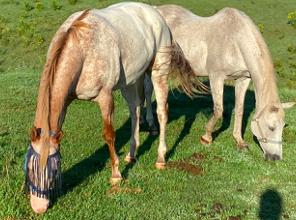Background
Behavioural Lateralization

Hemispheric specialization has been reported in a variety of taxa, including mammals, birds, fish, and insects and is a widespread phenomenon among vertebrates. Lateralized behaviour, which can be demonstrated as sensory or functional laterality, is the most conspicuous expression of hemispheric specialization. Individual level laterality has been reported to occur in a variety of species. Whereas lateralized behaviour at the population level is scarce. Nevertheless, certain lateralized behaviours observed in a given species have been reported to correlate with each other, for example handedness and footedness in humans.
Behavioural lateralization in horses
Horses are a particularly suitable species for studying lateralized behaviours due to their laterally placed eyes, separate nostrils, individually movable ears and their tendency to display side-biases in certain behaviours. No study so far has assessed more than 1 or 2 behaviours at the same time in a given population. In addition, it is currently not known whether certain lateralized behaviors observed in horses may correlate with each other or occur at the population level. It is based on this information that the aims of the project were selected.
Aims
The aim of the present study was to:
- determine if lateralized behavior is present in a catalogue of natural behaviours in individual horses
- determine if horses display lateralized behavior at the population level
- provide the first comprehensive analysis of correlation of lateralized behaviours in horses
Responsible for this page:
Director of undergraduate studies Biology
Last updated:
05/08/21
